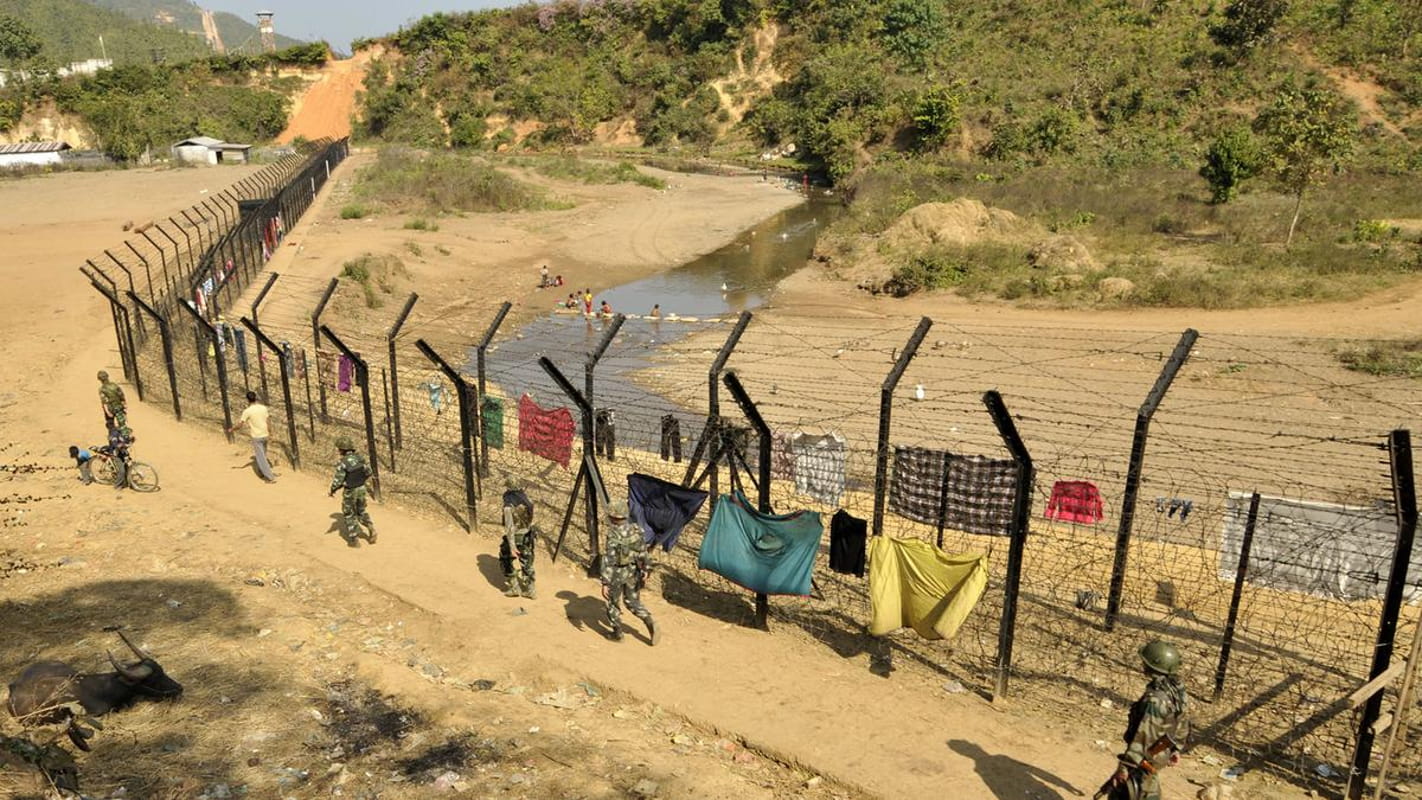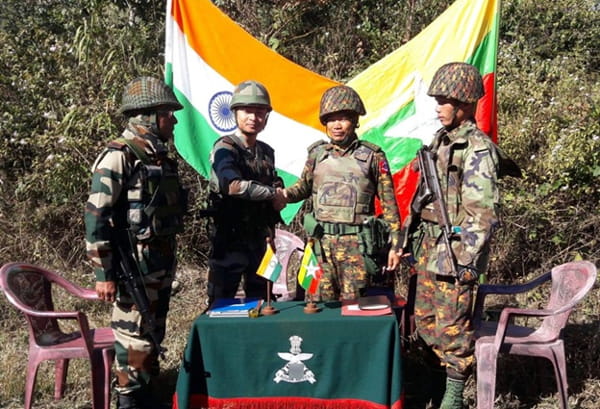
Indian Army personnel keep up vigil along the India-Myanmar international border. File photo. | Ritu Raj Konwar.
Myanmar’s post-coup turmoil has fundamentally transformed India’s northeastern frontier from a stable periphery into a contested “de facto buffer” zone. This shift demands that New Delhi reconceptualise its Look East ambitions and military doctrines in tandem. By embracing adaptive connectivity frameworks, frontier-specific force postures and robust intelligence partnerships, India can navigate the uncertainties of Myanmar’s internal conflict. Such recalibration not only safeguards India’s territorial integrity but also preserves its strategic gateway to Southeast Asia albeit through a border that will, for the foreseeable future, remain far from uniformly governed.
Introduction
Since the military coup in Naypyidaw in February 2021, Myanmar has descended into a protracted conflict marked by intensified insurgencies against the junta and widespread civilian resistance. What was once a relatively stable frontier for India’s northeastern states has become a zone of unpredictable violence, humanitarian distress and refugee flows. This evolving security landscape compels New Delhi to reassess both its diplomatic “Look East” ambitions and the contours of its military posture along the 1,600 km border. This opinion piece argues that Myanmar’s border instability has effectively created a “de facto buffer” zone one that is neither sovereign Indian territory nor reliably governed Myanmar land and that India’s policies and doctrines must adapt accordingly.
The Post-Coup Security Landscape in Myanmar
The collapse of institutional governance following the coup has emboldened longstanding ethnic armed organisations (EAOs) and nascent People’s Defence Forces to intensify operations in border regions. In Chin, Kachin and northern Shan States, clashes between the junta and EAOs have surged, with civilian villages caught in the crossfire. Simultaneously, anti-junta guerrilla groups have established bases mere kilometres from India’s border, exploiting dense forests and porous terrain for sanctuary and logistics. The United Nations has estimated that over 170,000 Myanmar nationals have sought refuge in Indian border districts since 2021, overwhelming local administrations and humanitarian agencies (UNHCR).
A parallel phenomenon is the proliferation of illicit economic networks. Armed groups taxed cross-border trade in jade, timber and narcotics, undermining both Myanmar’s sovereignty and India’s rule of law in border markets. In states such as Arunachal Pradesh and Nagaland, security forces report a marked increase in arms smuggling and transnational crime linked to Myanmar-based militias. Consequently, the border region functions as a hybrid space partially controlled by non-state actors, partially by the Tatmadaw (Myanmar Armed Forces), and peripheral to central authority.
Implications for India’s Look East Policy
India’s Look East Policy, inaugurated in the early 1990s and rebranded as Act East in 2014, envisaged deeper engagement economic, cultural and strategic with Southeast Asia. Myanmar was always pivotal: its territory provides the shortest overland route to the ASEAN Economic Community. Yet, persistent instability jeopardises major projects such as the India-Myanmar-Thailand Trilateral Highway and the Kaladan Multimodal Transit Route. Road construction crews have been ambushed; port developments have been delayed by security clearances.
The strategic calculus must therefore shift. Rather than presuming a benign environment, New Delhi should negotiate project corridors with granular security guarantees, possibly integrating remote monitoring technologies and local stakeholder assemblies. India might also deepen collaboration with Myanmar’s civilian entities wherever feasible to ensure that infrastructure projects benefit host communities and not armed spoilers. A calibrated mix of hard and soft power can help salvage connectivity ambitions, but only if India acknowledges that the frontier now represents a contested buffer, not a secure springboard into ASEAN.
Reshaping Military Doctrines Along the Northeast Frontier
India’s military doctrines have historically focused on state-to-state conflicts and conventional threats. The one significant exception was counter-insurgency within the northeastern states themselves. Yet, doctrines seldom considered that insurgent back channels could be nourished from across an international border. The coup induced vacuums in Myanmar demand a doctrinal pivot towards “contested buffer operations”, blending conventional force posturing with specialised cross-border counter-insurgency capabilities.

India’s Assam Rifles and the Myanmar Army hold a post-level meeting at Pillar 41 in Manipur’s Churachandpur district, December 2018. | Eastern Command, Indian Army.
Firstly, the Indian Army’s existing force structure on the frontier needs augmentation with rapid-reaction units trained in jungle warfare and interdiction of guerrilla logistics. The recently raised Mountain Strike Corps could be re-oriented for limited cross-border pursuits under strict rules of engagement and with explicit diplomatic authorisation. Secondly, intelligence cooperation with like-minded neighbours Thailand, Indonesia and even the US under the Quad umbrella must be enhanced to track the movement of militants, arms and illicit goods.
Thirdly, the Indo-Myanmar border should be redefined functionally: certain stretches might benefit from ‘soft’ barriers such as sensor arrays and drone patrols, while others where civilian trade predominates, could feature improved customs-led checkpoints.
Moreover, the Assam Rifles, long entrusted with internal security, should be further professionalised and equipped with advanced surveillance platforms. Their dual civil-military character makes them ideal for “hearts and minds” operations among the local tribes, mitigating the humanitarian fallout of refugee influxes and countering EAO propaganda. Joint exercises with the Tatmadaw’s non-junta elements, where possible, could foster tactical dialogue and confidence-building measures, especially in border management.
Policy Recommendations
1. Adaptive Connectivity Frameworks
Reframe cross-border projects as modular initiatives, each governed by project-specific security pacts and community engagement protocols. This approach allows India to pause or accelerate segments in response to ground realities, rather than suspending entire corridors.
2. Enhanced Border Management Technology
Deploy a network of low-altitude drones, ground sensors and geospatial analytics along high-risk border sectors. These systems should feed real-time data to integrated command posts in Guwahati and Shillong, reducing reliance on human patrols in dangerous terrain.
3. Strategic Intelligence Partnerships
Broaden intelligence-sharing agreements under the BIMSTEC and Quad frameworks to include non-traditional security threats emanating from Myanmar. Joint task forces can map insurgent financing and disrupt illicit networks before they reach Indian territory.
4. Community-Centric Humanitarian Outreach
Establish cross-border health and education camps in partnership with local civil society groups. By alleviating humanitarian distress among displaced Myanmar nationals and border communities, India can undercut insurgent recruitment and build local goodwill.
5. Doctrinal Revision and Training
Integrate “contested buffer operations” as a defined concept in the doctrine publications of the Indian Army and Assam Rifles. Conduct scenario-based war games that simulate rapid insurgent incursions from Myanmar, ensuring preparedness for low-intensity conflicts with transnational linkages.
Conclusion
Myanmar’s post-coup turmoil has fundamentally transformed India’s northeastern frontier from a stable periphery into a contested “de facto buffer” zone. This shift demands that New Delhi reconceptualise its Look East ambitions and military doctrines in tandem. By embracing adaptive connectivity frameworks, frontier-specific force postures and robust intelligence partnerships, India can navigate the uncertainties of Myanmar’s internal conflict. Such recalibration not only safeguards India’s territorial integrity but also preserves its strategic gateway to Southeast Asia albeit through a border that will, for the foreseeable future, remain far from uniformly governed.
(Exclusive to NatStrat)